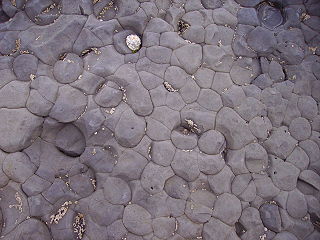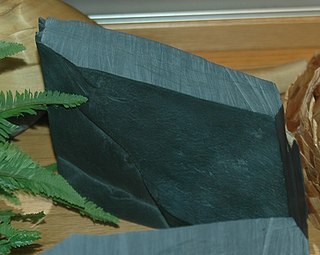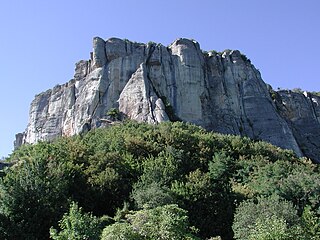Related Research Articles

Sandstone is a clastic sedimentary rock composed mainly of sand-sized silicate grains. Sandstones comprise about 20–25% of all sedimentary rocks.

Shale is a fine-grained, clastic sedimentary rock formed from mud that is a mix of flakes of clay minerals and tiny fragments of other minerals, especially quartz and calcite. Shale is characterized by its tendency to split into thin layers (laminae) less than one centimeter in thickness. This property is called fissility. Shale is the most common sedimentary rock.

Sedimentary rocks are types of rock that are formed by the accumulation or deposition of mineral or organic particles at Earth's surface, followed by cementation. Sedimentation is the collective name for processes that cause these particles to settle in place. The particles that form a sedimentary rock are called sediment, and may be composed of geological detritus (minerals) or biological detritus. The geological detritus originated from weathering and erosion of existing rocks, or from the solidification of molten lava blobs erupted by volcanoes. The geological detritus is transported to the place of deposition by water, wind, ice or mass movement, which are called agents of denudation. Biological detritus was formed by bodies and parts of dead aquatic organisms, as well as their fecal mass, suspended in water and slowly piling up on the floor of water bodies. Sedimentation may also occur as dissolved minerals precipitate from water solution.

Sediment is a naturally occurring material that is broken down by processes of weathering and erosion, and is subsequently transported by the action of wind, water, or ice or by the force of gravity acting on the particles. For example, sand and silt can be carried in suspension in river water and on reaching the sea bed deposited by sedimentation; if buried, they may eventually become sandstone and siltstone through lithification.
Sedimentology encompasses the study of modern sediments such as sand, silt, and clay, and the processes that result in their formation, transport, deposition and diagenesis. Sedimentologists apply their understanding of modern processes to interpret geologic history through observations of sedimentary rocks and sedimentary structures.

Conglomerate is a clastic sedimentary rock that is composed of a substantial fraction of rounded to subangular gravel-size clasts. A conglomerate typically contain a matrix of finer-grained sediments, such as sand, silt, or clay, which fills the interstices between the clasts. The clasts and matrix are typically cemented by calcium carbonate, iron oxide, silica, or hardened clay.

Mudstone, a type of mudrock, is a fine-grained sedimentary rock whose original constituents were clays or muds. Mudstone is distinguished from shale by its lack of fissility.

A pelite or metapelite is a metamorphosed fine-grained sedimentary rock, i.e. mudstone or siltstone. The term was earlier used by geologists to describe a clay-rich, fine-grained clastic sediment or sedimentary rock, i.e. mud or a mudstone, the metamorphosed version of which would technically have been a metapelite. It was equivalent to the now little-used Latin-derived term lutite. A semipelite is defined in part as having similar chemical composition but being of a crystalloblastic nature.

Argillite is a fine-grained sedimentary rock composed predominantly of indurated clay particles. Argillaceous rocks are basically lithified muds and oozes. They contain variable amounts of silt-sized particles. The argillites grade into shale when the fissile layering typical of shale is developed. Another name for poorly lithified argillites is mudstone. These rocks, although variable in composition, are typically high in aluminium and silica with variable alkali and alkaline earth cations. The term pelitic or pelite is often applied to these sediments and rocks. Metamorphism of argillites produces slate, phyllite, and pelitic schist.

Arenite is a sedimentary clastic rock with sand grain size between 0.0625 mm (0.00246 in) and 2 mm (0.08 in) and contain less than 15% matrix. The related adjective is arenaceous. The equivalent Greek-derived term is psammite, though this is more commonly used for metamorphosed sediments.

Mudrocks are a class of fine-grained siliciclastic sedimentary rocks. The varying types of mudrocks include siltstone, claystone, mudstone, slate, and shale. Most of the particles of which the stone is composed are less than 1⁄16 mm and are too small to study readily in the field. At first sight, the rock types appear quite similar; however, there are important differences in composition and nomenclature.

Clastic rocks are composed of fragments, or clasts, of pre-existing minerals and rock. A clast is a fragment of geological detritus, chunks and smaller grains of rock broken off other rocks by physical weathering. Geologists use the term clastic with reference to sedimentary rocks as well as to particles in sediment transport whether in suspension or as bed load, and in sediment deposits.

Calcarenite is a type of limestone that is composed predominantly, more than 50 percent, of detrital (transported) sand-size, carbonate grains. The grains consist of sand-size grains of either corals, shells, ooids, intraclasts, pellets, fragments of older limestones and dolomites, other carbonate grains, or some combination of these. Calcarenite is the carbonate equivalent of a sandstone. The term calcarenite was originally proposed in 1903 by Grabau as a part of his calcilutite, calcarenite and calcirudite carbonate classification system based upon the size of the detrital grains composing a limestone. Calcarenites can accumulate in a wide variety of marine and non-marine environments. They can consist of grains of carbonate that have accumulated either as coastal sand dunes (eolianites), beaches, offshore bars and shoals, turbidites, or other depositional settings.

Under the Dunham classification system of limestones, a wackestone is defined as a mud-supported carbonate rock that contains greater than 10% grains. Most recently, this definition has been clarified as a carbonate-dominated rock in which the carbonate mud component supports a fabric comprising 10% or more very fine-sand grade or larger grains but where less than 10% of the rock is formed of grains larger than sand grade .
Psammite is a general term for sandstone. It is equivalent to the Latin-derived term arenite and is commonly used in various publications to describe a metamorphosed sedimentary rock with a dominantly sandstone protolith. In Europe, this term was formerly used for a fine-grained, fissile, clayey sandstone. Pettijohn gives the following descriptive terms based on grain size, avoiding the use of terms such as "clay" or "argillaceous", which carry an implication of chemical composition:
Rudite is a general name used for a sedimentary rock composed of rounded or angular detrital grains, i.e. granules, pebbles, cobbles, and boulders, which are coarser than sand in size. Rudites include sedimentary rocks composed of both siliciclastic, i.e. conglomerate and breccia, and carbonate grains, i.e. calcirudite and rudstone. This term is equivalent to the Greek-derived term, psephite. Rudite was initially proposed by Grabau as "rudyte." It is derived from the Latin word rudus for "crushed stone," "rubbish," "debris," and "rubble".
Psephite is either a sediment or sedimentary rock composed of fragments that are coarser than sand and which are enclosed in a matrix that varies in kind and amount. It is equivalent to a rudite. Shingle, gravel, breccia, and especially conglomerate, would all be considered psephites. It is equivalent to the Latin-derived term rudite. Psephite is more commonly used for a metamorphosed rudite.
Tonstein is a hard, compact sedimentary rock that is composed mainly of kaolinite or, less commonly, other clay minerals such as montmorillonite and illite. The clays often are cemented by iron oxide minerals, carbonaceous matter, or chlorite. Tonsteins form from volcanic ash deposited in swamps.

A cobble is a clast of rock defined on the Udden–Wentworth scale as having a particle size of 64–256 millimeters (2.5–10.1 in), larger than a pebble and smaller than a boulder. Other scales define a cobble's size differently. A rock made predominantly of cobbles is termed a conglomerate. Cobblestone is a building material based on cobbles.
Calcilutite is a type of limestone that is composed of predominantly, more than 50 percent, of either clay-size or both silt-size and clay-size detrital (transported) carbonate grains. These grains consist either of fossil fragments, ooids, intraclasts, pellets, other grains, or some combination of them. The term calcilutite was originally proposed in 1903 by Grabau as a part of his calcilutite, calcarenite and calcirudite classification system based upon the size of the detrital grains composing a limestone. In the original classification of limestone according to the dominant grain-size, calcisiltites were not named and are classified as calcilutite. In this classification, which the majority of geologists follow, a calcilutite consists of both silt- and clay-size, less than 0.062 mm in diameter, grains. It is the carbonate equivalent of a mudstone. Calcilutites can accumulate in a wide variety of marine and lacustrine environments.
References
- 1 2 Potter, P.E., J.B. Maynard, and P.J. Depetris (2005) Muds and Mudstones. New York, New York, Springer. 279 pp. ISBN 978-3-540-22157-9
- ↑ Neuendorf, K.K.E., J.P. Mehl, Jr., and J.A. Jackson, J.A., eds. (2005) Glossary of Geology (5th ed.). Alexandria, Virginia, American Geological Institute. 779 pp. ISBN 0-922152-76-4
- ↑ Grabau, A.W. (1904) On the classification of sedimentary rocks. American Geologist. vol. 33, pp. 228-247.
- ↑ lutum . Charlton T. Lewis and Charles Short. A Latin Dictionary on Perseus Project .
- ↑ Pettijohn F. J. (1975), Sedimentary Rocks, Harper & Row, ISBN 0-06-045191-2